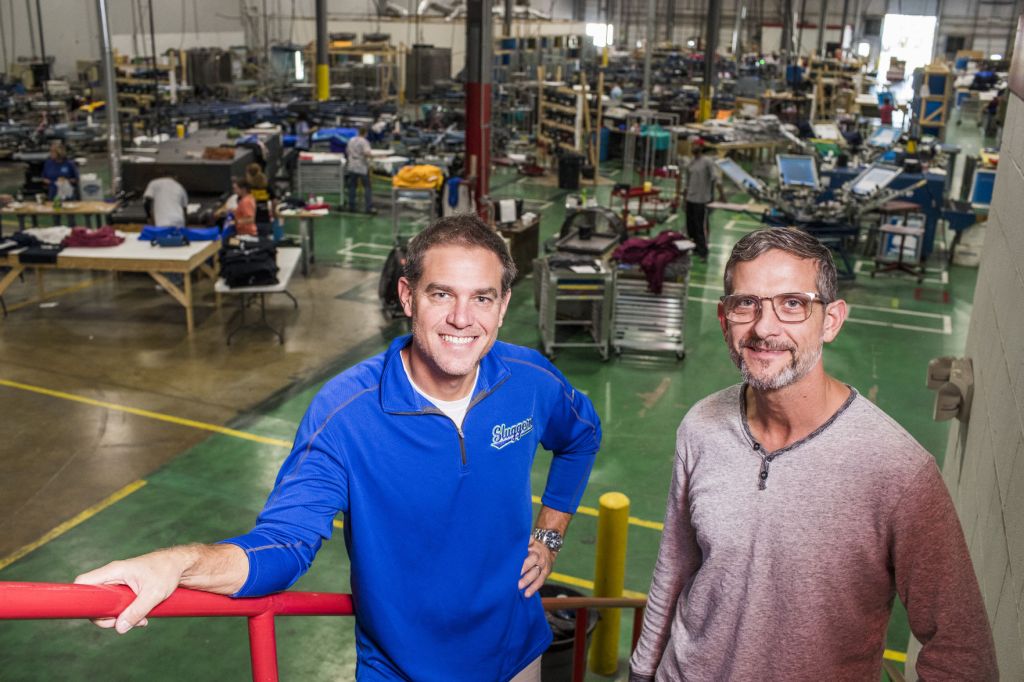Business basics fuel Blue Cotton’s explosive growth
Published 10:00 am Wednesday, October 18, 2017

- Blue Cotton co-owners Mike Coffey (left) and Warren Guyer stand in their factory on Friday, Oct. 13, 2017, in Bowling Green, Ky.
It’s another day at the office for Blue Cotton Inc. founder Mike Coffey. Dressed in shorts and an embroidered pullover, he makes his way around the company’s 51,000-square-foot plant, stopping to speak to an employee about a customer order at the company that does screen printing, embroidery and digital printing.
He’s right at home among the T-shirts and other clothing items and machinery on the plant floor, explaining that he’s not a “coat-and-tie person.”
Trending
That’s not all that sets Coffey and his company apart.
As a business owner who has made Inc. magazine’s list of the country’s fastest-growing companies and has earned the Bowling Green Area Chamber of Commerce Small Business Person of the Year Award, Coffey maybe could be expected to spout theories about business processes and throw out a few John Maxwell quotes.
Instead, Coffey explains with Zen-like simplicity how he has gone from peddling T-shirts on college campuses to running a company with more than 100 employees and annual revenue north of $7 million.
“It’s an accident that it happened, but it’s the result of a lot of purpose,” Coffey said while sitting in his smallish office overlooking the floor of the plant in Warren County’s South Industrial Park. “Because I did the things I said I was going to do, I was successful.
“Just the fact that I was trustworthy and cared about serving the customer helped the business grow. When you do a good job with stuff, you usually get more work.”
Sounds simple, but it hasn’t been.
Trending
Coffey, 50, didn’t set out to be an entrepreneur. A Louisville native, he earned degrees in finance and accounting at Western Kentucky University and wanted nothing more than to be a bean counter.
“I was supposed to be a CPA,” Coffey recalled. “I graduated from Western and thought that’s what I was going to do. People didn’t graduate from college and start their own businesses. They went to work for somebody else.”
Coffey broke that mold, but not by design. While waiting the several months it took back then to hear the results of his Certified Public Accountant exam, Coffey began selling T-shirts to fraternities and sororities.
“At the beginning, I was trying to find something to do until I got a real job,” he said. “It wasn’t traditional, and I didn’t embrace it in the beginning.”
Working with a screen printer in Alabama, Coffey was able to make a go of his one-man T-shirt business; but those early years were such a struggle that the fledgling entrepreneur at times questioned his career path.
“Then one day it hit me – there’s a whole industry out there doing what I’m doing, so why should I be ashamed of it?” Coffey recalled. “If it generates income, what difference does it make?”
The income generated was sparse at first as Coffey concentrated on finding customers on college campuses. With the help of Tim Earnhart, a friend and branding and advertising professional, he came up with the Blue Cotton name and logo in 1994. He wasn’t able to hire any employees until 1997, but the first two he hired are still with him.
Coffey bought his first screen printing press in 1998 and began operating out of space he rented from the Detrex Corp. plant on Bowling Green’s Emmett Avenue.
Earnhart recalls helping Coffey at that Emmett Avenue location in an all-night printing session to finish t-shirts for the Bowling Green 10K Classic. That busy night was a sign of what was to come for Blue Cotton.
The company moved to offices in the Corporate Park off Scottsville Road in 1999, and Coffey and partner Warren Guyer developed the strategies that would lead to Blue Cotton’s rapid growth.
He continued to specialize in selling to fraternities and sororities, but Coffey expanded Blue Cotton’s reach by going online.
“We went online and started selling all over the country,” he said. “We did pretty well, but our niche was still fraternities and sororities. In 2007, we decided not to limit ourselves to that one little segment.”
Working with Bowling Green website design company Hitcents, Blue Cotton developed an interactive web presence that turned the company’s growth curve northward.
“With the interactive website, people could design their own shirts,” Coffey said. “We really grew after that.”
Coffey said Blue Cotton grew by 30 percent or more each year for nine consecutive years.
“He tapped into a global commerce opportunity,” said Earnhart. “Mike recognized that he could sell more than just T-shirts to fraternities and sororities. He saw the idea of custom shirts and clothing and expanded his reach.”
Which led to the expansion of Blue Cotton. The company built on to its offices in the Corporate Park as employment grew to some 50 workers.
Guyer, formerly in management with Detrex, has been involved in that growth since joining Coffey in 2000. He is now a part owner along with Coffey and Brad Wayland.
“We made the decision to grow the business instead of sitting still,” Guyer said. “We could have failed at this. Most small businesses do fail. But we decided to grow because we realized we were taking care of a lot of families.
“We’re looking at the longevity of the business. We want to make sure it’s going to be here.”
The Blue Cotton family has continued to grow, prompted by last year’s long-term agreement to print for Virginia-based apparel company CustomInk. That contract led to Blue Cotton moving to the South Industrial Park, where it occupies roughly half of a 111,00-square-foot building and leases the rest.
“Because of that production agreement, we have been able to expand,” Coffey said. “We’re in the center of a large population area, with 70 percent of the U.S. population within a two-day shipping area. We’re one of 10 large-volume printers that CustomInk uses.”
Blue Cotton now has 115 employees working two shifts, a far cry from Coffey’s early days. But one thing hasn’t changed: his commitment to custom orders.
“Screen printing is designed to be a little bit of setup and a lot of production,” Coffey said. “What we do is a lot of setups and a little production. We do small runs, and we go through about 500 screens per day.”
By specializing in those small runs, Blue Cotton has positioned itself to take advantage of how the screen printing business has evolved. Coffey explained that most high-volume jobs have moved out of the country.
“All the little work, you can’t send that overseas,” he said. “Over a period of years that’s what we got good at. The market kinda went to small runs. When that became what people needed, we were ready.”
Coffey, who usually comes to work mid-morning and then stays late so he can interact with both of the plant’s shifts, hasn’t forgotten the business basics that helped his company grow.
“To run a successful business, the customer has to have a good experience and you must have a good employee experience,” he said. “I’m working for two groups of people, trying to keep customers happy and employees happy. The employee experience has become more important to us as we’ve grown.”
Pleasing customers and employees while remaining profitable is a juggling act, but it’s one that Coffey and his partners have executed so well that Blue Cotton has attracted attention from larger companies.
“We’ve had interest from other companies trying to buy us,” Coffey said. “We’ve had two serious offers, but we’re just not ready to do that.”







